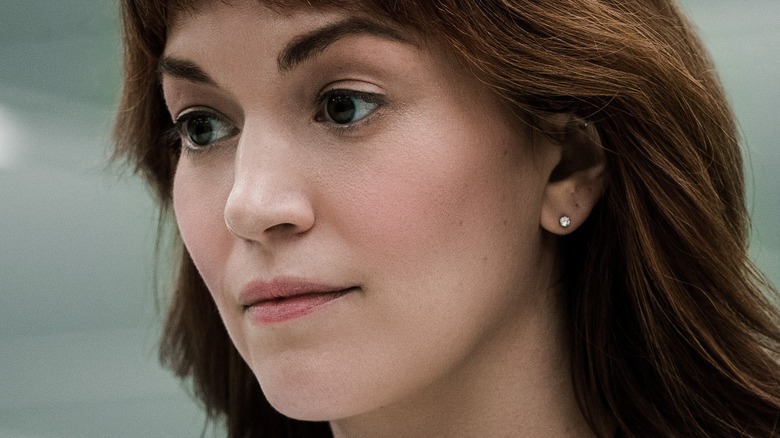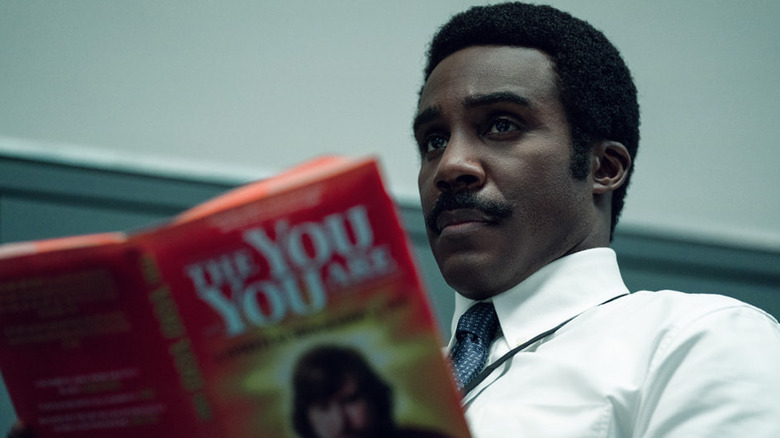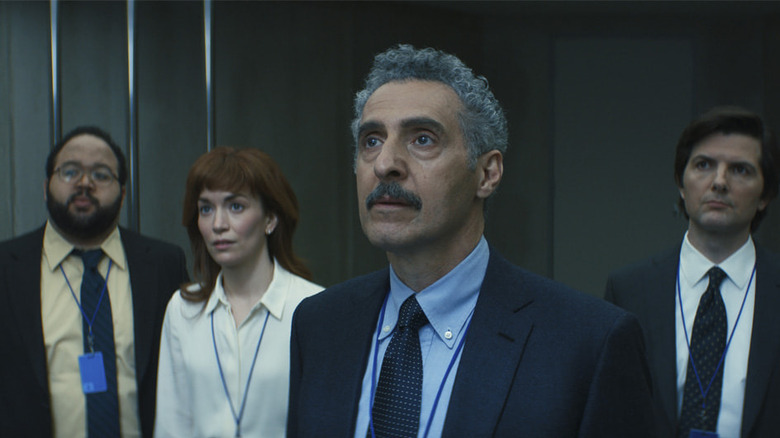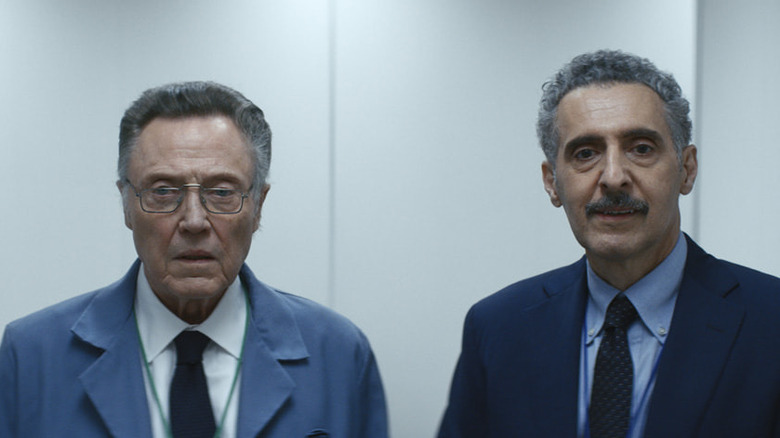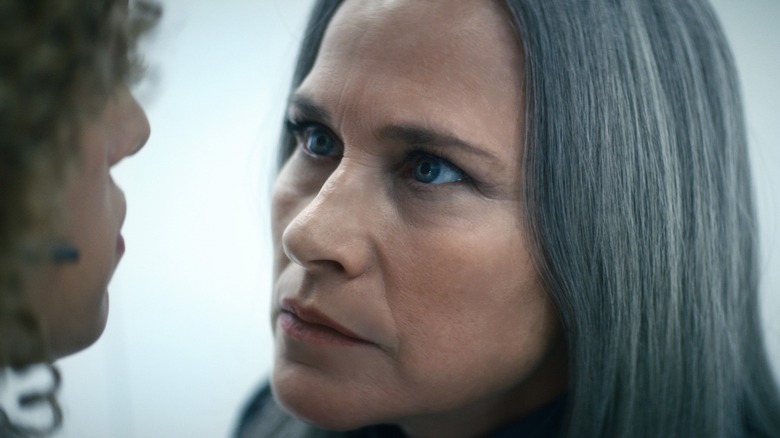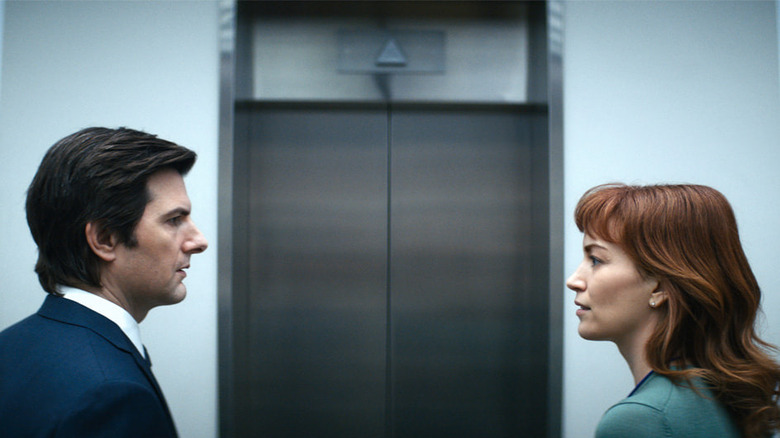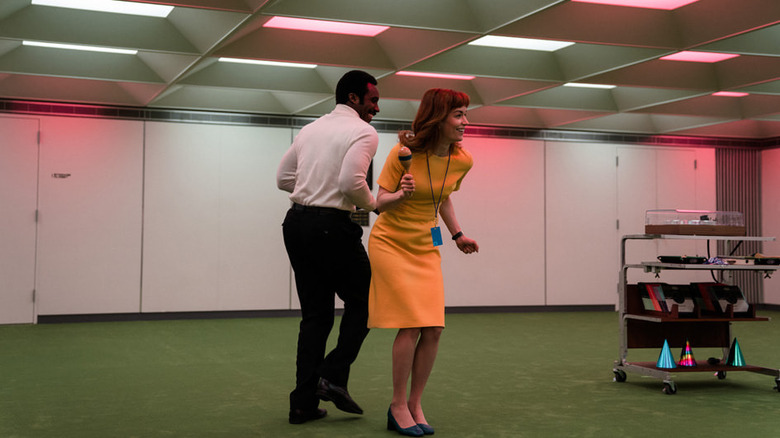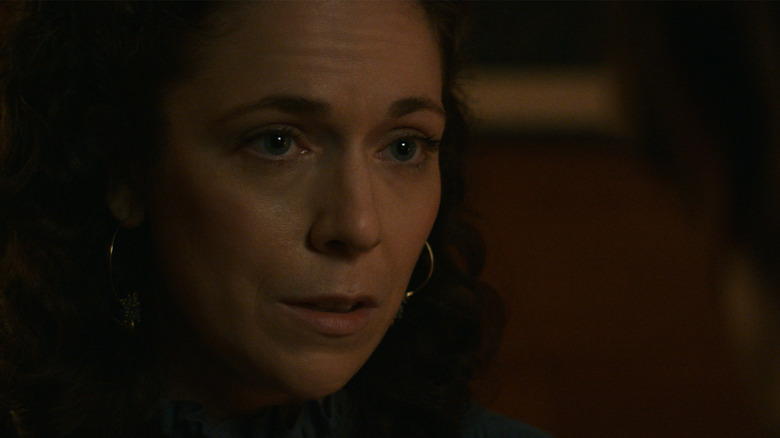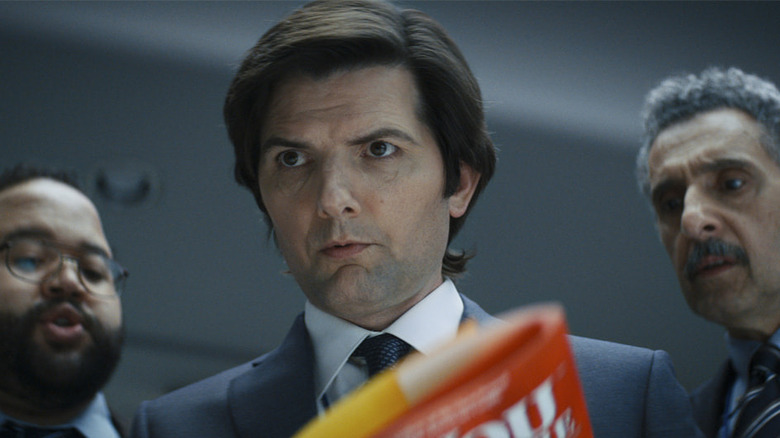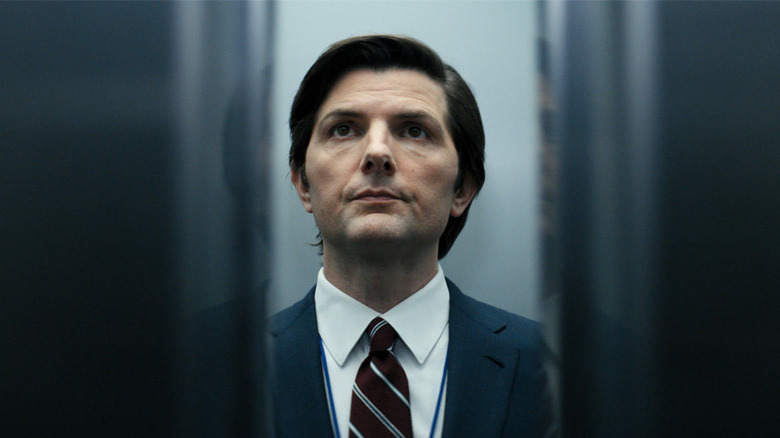Behind-The-Scenes Facts About Severance That Will Jog Your Memory
For those employed by the biotechnology company Lumon Industries in the dystopian world of Apple TV+'s "Severance," corporate angst takes on a surrealist edge as they find themselves unable to ever truly clock out from work. The pilot introduces us to Mark (Adam Scott), who has recently had the so-called severance, an operation that divides your work and home lives from one another. This means that, every day, when he attempts to go home, he finds himself walking back into the office the next morning with no recollection of what occurred outside. While this is obviously torture, his home self, or his "outie," has no idea what's happening to his "innie."
"Severance" has a lot of things in its corner that make it an obvious hit, from the pitch-black comedy to the incredible cast and the tragic reality they find themselves attempting to navigate. The way it echoes the increasingly automated world in which we live is what gives the series such a haunting relevance. With so many secrets revealed in the first season, it may come as little surprise to learn that the world behind-the-scenes of the show is likewise full of little surprises. Unlike Mark and his co-workers, we can easily access this information without causing a catastrophic domino effect, meaning there is no time like the present to look into some of the IRL moments that went into making this series so great.
It's based on a true story
Perhaps the most disturbing thing about "Severance" is that the premise isn't totally outside of the realm of possibility, and that's no accident. According to creator and writer Dan Erickson, as upsetting as "Severance" can be, it was very much inspired by real life experiences. The idea started to form in his mind as he attempted to deal with the drudgery of working a 9 to 5 job. "I caught myself wishing I could just disassociate from the next eight hours," he said in an interview with Inverse. "It occurred to me that that's a messed up thing to wish for. We've got such precious little time on this Earth, but in that moment I totally would have given up those eight hours."
Fortunately, not everything in "Severance" is based in reality. In the same interview, Erickson elaborated on a number of fictional inspirations as well, citing films like "The Truman Show" and "Brazil." He also name-dropped the online phenomenon known as "The Backrooms" as an influence. A "weird online urban legend" that originated on creepypasta, it revolves around an endless maze of empty offices glowing with relentless fluorescent lights. Once stuck in the Backrooms, there is apparently little chance of escape, which will sound familiar to anyone who has tuned into "Severance." Indeed, the horror of mundanity as it ties into our work lives will be all too relatable for plenty of adults, which is where the horror of the series lies. As Erickson concluded, "It's scary when you really look at how much of our self-worth and identity are wrapped up in our jobs."
The series was filmed out of order
If you found yourself wondering how the cast managed to pull off the continuous sense of surprise and confusion throughout each of the plot twists, series director Ben Stiller told BuzzFeed that the organization of how the scenes were filmed may have helped to keep the actors guessing. "Severance" was filmed over a year and a half, with the sequences kept purposefully out of order so that the disorientation of the cast would be palpable.
"They had to sometimes, on one day, do parts of episodes from like three or four different episodes and have to be jumping around and [know] where they were and if they were an innie or an outie," Stiller said. "It was really, really very challenging." How did the cast deal with this challenge? Britt Lower did a bunch of detailed doodles to keep her character's continuity straight in her own mind. "I drew little pictures of Helly's action scenes, so I could go, 'Oh, I've smashed through a window here, and then I ran down a hallway,'" she said in the same interview.
Throughout the first season, as the outie and innie worlds slowly begin to collide with one another, the surreal nature of the series only increases. With both sides now more aware of one another, it's hard to say if the series will continue to lean into the heavy twists of the first season, or — like similarly themed shows such as "The Good Place" and "Westworld" — focus more on linear storytelling and characterization going forward. Either way, the off-putting effect of the world inside of Lumon Industries will always be associated with the success of the show, and this sleight of hand directorial approach may well have played a big role in that.
Casting Christopher Walken was John Turturro's idea
Among the most genuinely touching aspects of this uncanny satire is the office romance between Irving (John Turturro) and Burt (Christopher Walken), two men whose attraction to one another is both immediate and surprisingly sweet (that is, until a devastating twist in the final episodes of the first season). The personal chemistry between these two long-time friends and peers is apparent in all of their team-ups, having first worked together in the 1995 film "Search and Destroy." After that experience, Turturro cast Walken in several films he directed, including "Illuminata," "Romance & Cigarettes," and "The Jesus Rolls."
Perhaps then it shall come as no surprise that Turturro was the one who suggested Walken for the role of Burt. Noting that the two were already comfortable with each other and that would lend to their shared scenes, Turturro ran the idea by Stiller, who immediately agreed that Walken was the perfect choice. Though they both admit that they seldom socialize outside of work, they love chatting to each other on set. In an interview with The New York Times, they theorized about the schematics of what exactly makes them a great team.
"I'm a fan of Chris's. We get along and we share a sense of humor," Turturro said. "Chris is not a 'head' actor — you feel his body in the scene. I like to use my body, too, so I think it's a good match." According to Walken, the fact that he and Turturro know each other well translates onto the screen. "When people are acting together, you can tell when they know each other, and particularly if they like each other and are comfortable together," he said. "It's a kind of unspoken thing, but it really shows up."
Cast members sometimes got lost on set
The disorienting layout of Lumon Industries is a major part of what makes "Severance" so unsettling, and several cast members have revealed that the maze-like quality of the set made for a disorientating experience. Speaking to Looper in an exclusive interview, Tramell Tillman (Milchick) called the set a "labyrinth," adding: "It would take us, as actors, several minutes to find out where we were because we'd get lost. They use a little TV camera magic to elongate some of the spaces to create longer walls, but it's pretty spot on, what you see."
Patricia Arquette, who plays Mark's boss Harmony Cobel in the series, had the same trouble. In an interview with Entertainment Weekly, Arquette said that she and her castmates "would get lost on the set all the time." According to the Oscar winner, the crew "were always changing doorway openings, adding walls, and taking walls out. We'd be in there like a rat in a maze, like, 'I'm on set, I can't find you guys!'"
Cobel is one of the most interesting characters in the series, initially set up as the antagonist only for us to slowly realize that, while she may have more information than Mark, that doesn't mean she has a handle on things. Arquette's performance is a major part of what makes the character click, but she notes that the cast and crew committing so hard certainly helped flesh things out down to the smallest detail. "The layers that went into this world, I can't even really explain to you," she said.
Mark and Helly's roles were reversed
At the heart of this disorientating psychological thriller is the story of Mark and Helly, two highly troubled individuals who are able to bond despite their nightmarish environment. Though the two have a shared sense of dissatisfaction with the world they inhabit, they offer one another hope, and soon an attraction blooms. Yet, it turns out that their respective roles and the dynamic between them changed during the creation of the series. During a panel with the cast at San Diego Comic-Con 2022, creator Dan Erickson revealed that Mark and Helly's roles were initially reversed and it gave the series a whole different vibe when they were adjusted.
The original story featured Mark rather than Helly awakening on the table to a new reality, shaken to his core by the discovery that he will never be able to go home again. However, as "Severance" viewers will know, that is actually how we meet Helly in the series, and her rebellion against this is what makes up most of her story. "Once we had the idea for it to be Helly, there is an obvious thing of once you bring anybody into a setting that previous was all one way, and you get to introduce an element of diversity to the environment, you're going to have new ideas introduced that are going to help and improve things," Erickson said (via BuzzFeed). "So this idea that it was kind of this boys club, and that Helly was the one who steps in and sort of becomes the instigator of change."
The dance scene was shot like a music video
Among the most memorable sequences in "Severance" is the dance scene from Episode 7. It comes about when the downtrodden staffers at Lumon start connecting the dots regarding their situation. They're on the verge of realizing that something isn't right with their creepy workplace when floor manager Milchick appears and informs them that they've won a so-called "music dance experience." He offers them a choice of tunes, and they opt for some "defiant jazz" (the title of this episode). This is when things truly start going crazy.
In an interview with IndieWire, cinematographer Jessica Lee Gagné and production designer Jeremy Hindle described the making of this bizarre scene, which manages to be both joyous and just as mortifying as anything else that happens on the show all at once. Explaining how the cameras worked to create a removed effect throughout most of the series and how that changed during this scene, Gagné said, "We almost wanted it to feel like a music video."
As the scene goes on, the change from the standard fluorescent vibe of the office to increasingly ominous flashing red lights sets up the dark turn that the dance party ultimately takes. Little tricks like having a lowered ceiling to mimic a nightclub combined with Stiller's direction and the performances of the actors made for a perfectly off-putting and show-defining scene. Writer and creator Dan Erickson revealed during the BuzzFeed cast interview that he takes extra pride in their work here, citing this scene as his favorite part of the series. "It was just glorious in every single way," he said.
Devon was really in the dark
Though most of the characters we meet in "Severance" have innies and outies, Mark's sister Devon is on the outside all along. This gives her special insight into the situation that the main cast of characters are in, but she actually knows precious little about the inner workings of Lumon Industries. Much of Devon's concern is for her brother, who she knows is suffering but who she hopes is being helped by the separation between his selves. Actor Jen Tullock, who plays Devon, decided that it would be best if she didn't know about the major twists so she could remain as in the dark about the reality of the severance as her character is.
"My character is on the outside world the entire time, so I thought I didn't need to be privy to what was happening on the inside if she wasn't," Tullock explained in the BuzzFeed cast interview. "So, I kind of intentionally kept myself away from the buttons on some of the storylines towards the end of the season." Tullock's performance remains one of the highlights of the series as the sense of realism she brings to her acting seems to help counteract the surreal atmosphere of Lumon. In that way, choosing not to read ahead and see what became of Devon helped inform her role — and it made watching the finished product a more enjoyable experience for her. "I watched it with friends for the first time and there were a couple of twists where I was like, 'Oh!,' because I didn't know."
A random chicken appeared on set one day
During an appearance on "The Drew Barrymore Show," Britt Lower noted that the filming experience on "Severance" could be a bit agonizing due to the monotonous layout and lack of windows on the set. She went on to reveal that there were a few little surprises along the way that helped keep things in perspective. Filming in the Bronx, a door was left open at one point, and it allowed for a surprisingly magical moment. As Lower explained, "A very friendly chicken walked onto our soundstage out of nowhere and starts making itself at home." Before long, the chicken had become the unofficial mascot of the show.
Over a reel showing videos and photos of the chicken, Lower described the way that certain members of the team befriended the bird. "It's like sitting on the sound booth, they're feeding it strawberries, it goes outside, someone's holding an umbrella." Though the origin of the chicken remains unknown, and we may never know what happened to it after filming wrapped, Lower and company felt rejuvenated by the experience. "We all became so endeared by this chicken who had just arrived, this random arrival of a chicken at our sound stage, and it brought everyone so much joy," Lower said. "And it was the perfect metaphor for the show where a lot of bizarre things happen."
Adam Scott's performance was inspired by a Michael Keaton movie
The innie/outie arrangement may seem like a study of opposites, with a work self and a home self each functioning in different and often diametrically opposed capacities. Yet, one of the most fascinating elements of "Severance" is that nothing is as simple as it seems. Indeed, Adam Scott noted in the BuzzFeed cast interview that he initially approached the innie and outie versions of Mark as two totally different characters. However, he realized that this wasn't the right way to go after Ben Stiller told him about something Michael Keaton once did. "I remember Ben telling me a story about visiting Michael Keaton on the set of 'Multiplicity' and seeing that he had a whiteboard or something like charts because he played like seven different versions of the same character in that movie," Scott said. "So, he had a chart with a diagram of where each version of the character was at a different point."
Considering the extremes of hopelessness and optimism of Mark's two selves, this makes a lot of sense and shines a light on what makes Scott's performance work so well. Britt Lower also affirmed this, explaining the importance of showing the duality of a single character rather than two characters at odds. Despite her outie self showing an almost unreal level of callousness to her plight throughout the first several episodes, we soon discover that the line between them is more blurred than we could have imagined. "The innie is kind of this raw material that hasn't been affected by years of memories and the stories that we tell ourselves," Lower said. "And my outie is much more seen in a presentational scenario, so she's much more aware that people are looking at her."
